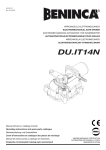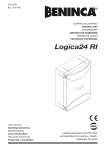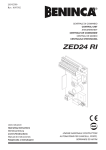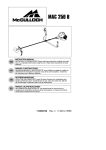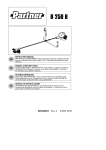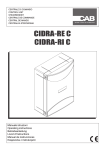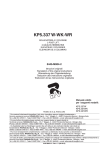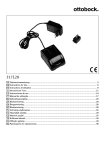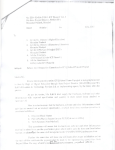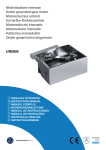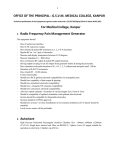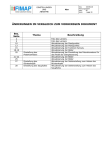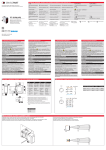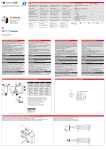Download KEN3/4 RI
Transcript
L8542371 Rev. 07/05/00 CENTRALE DI COMANDO CONTROL UNIT STEUEREINHEIT CENTRALE DE COMMANDE CENTRAL DE MANDO CENTRALKA STEROWANIA CP.K3-RE CP.K3-RI CP.K4-RE CP.K4-RI Libro istruzioni Operating instructions Betriebsanleitung Livret d’instructions Manual de instrucciones Książeczka z instrukcjami UNIONE NAZIONALE COSTRUTTORI AUTOMATISMI PER CANCELLI, PORTE, SERRANDE ED AFFINI Dichiarazione CE di conformità EC declaration of confirmity EG-Konformitatserklarung Déclaration CE de conformité Declaracion CE de conformidad Deklaracja UE o zgodności Con la presente dichiariamo che il nostro prodotto We hereby declare that our product Hiermit erklaren wir, dass unser Produkt Nous déclarons par la présente que notre produit Por la presente declaramos que nuestro producto Niniejszym oświadczamy że nasz produkt CP.K3-RE / CP.K3-RI / CP.K4-RE / CP.K4-RI è conforme alle seguenti disposizioni pertinenti: complies with the following relevant provisions: folgenden einschlagigen Bestimmungen entspricht: correspond aux dispositions pertinentes suivantes: satisface las disposiciones pertinentes siguientes: zgodny jest z poniżej wyszczególnionymi rozporządzeniami: Direttiva sulla compatibilità elettromagnetica (89/336/ CCE, 93/68/CEE) EMC guidelines (89/336/EEC, 93/68/EEC) EMV-Richtlinie (89/336/EWG, 93/68/EWG) Directive EMV (89/336/CCE, 93/68/CEE) (Compatibilité électromagnétique) Reglamento de compatibilidad electromagnética (89/336/ MCE, 93/68/MCE) Wytyczna odnośnie zdolności współdziałania elektromagnetycznego (89/336/EWG, 93/68/EWG) Direttiva sulla bassa tensione (73/23/CEE, 93/68/CEE) Low voltage guidelines (73/23/EEC, 93/68/EEC) Tiefe Spannung Richtlinie (73/23/EWG, 93/68/EWG) Directive bas voltage (73/23/CEE, 93/68/CEE) Reglamento de bajo Voltaje (73/23/MCE, 93/68/MCE) Wytyczna odnośnie niskiego napięcia (73/23/EWG, 93/ 68/EWG) Norme armonizzate applicate in particolare: Applied harmonized standards, in particular: Angewendete harmonisierte Normen, insbesondere: Normes harmonisée utilisées, notamment: Normas armonizadas utilzadas particularmente: Normy standard najczęściej stosowane: Norme armonizzate applicate in particolare: Applied harmonized standards, in particular: Angewendete harmonisierte Normen, insbesondere: Normes harmonisée utilisées, notamment: Normas armonizadas utilzadas particularmente: Normy standard najczęściej stosowane: EN 55014-1, EN 55014-2, EN 61000-3-2, EN 61000-3-3 EN 60204-1, EN 60335-1 Benincà Luigi, Responsabile legale. Sandrigo, 05/04/2004. 2 Automatismi Benincà Srl Via Capitello, 45 36066 Sandrigo (VI) ITALIA 30 N L 24 20 0 J2 DAS Close DAS 8K2 J2 DAS Open DAS N.C. 2AF V AUX 0 V MO T F1 DAS 8k2 DAS SHIELD ANT ANT 24 25 26 27 SERVICE LIGHT 24Vac/15W RADIO POWER S1 1 TCA 230V:T1A 120V:T2A AMP-O 8 AMP-C SWC-R SWO-R SWC F2 SWO STP PH OP CH PP PGM 18 19 20 21 22 U6 SWC-R SWO-R SWC SWO COM L1 N1 P.P 4 5 6 7 8 9 10 11 12 13 14 15 16 17 P.P. OPEN CLOSE PHOT LAMP 24Vac STOP 24Vac 500mA max M COM N L 230Vac 50Hz SCA 24Vac/3W 3 Centrali di comando CP.K3-RE / CP.K3-RI / CP.K4-RE / CP.K4-RI Centrali di comando per motori 24Vdc di potenza non superiore a 120W. AVVERTENZE GENERALI a) L’installazione elettrica e la logica di funzionamento devono essere in accordo con le normative vigenti. b) I conduttori alimentati con tensioni diverse, devono essere fisicamente separati, oppure devono essere adeguatamente isolati con isolamento supplementare di almeno 1 mm. c) I conduttori devono essere vincolati da un fissaggio supplementare in prossimità dei morsetti. d) Ricontrollare tutti i collegamenti fatti prima di dare tensione. e) Controllare che le impostazioni dei Dip-Switch siano quelle volute. f) Gli ingressi N.C. non utilizzati devono essere ponticellati. FUNZIONI INGRESSI/USCITE 4 N° Morsetti Funzione Descrizione 1-2 4-5 6-7 8-9 10-11 12 13 Alimentazione Motore 24Vdc Lampeggiante 24 Vac SCA COM STOP 14 PHOT 15 16 17 18 19 OPEN CLOSE Passo-Passo COM SWO 20 SWC 21 SWO-R 22 SWC-R 24-25 Antenna 26-27 COSTA Ingresso 230Vac 50Hz (1-Neutro/2-Fase) Collegamento al motore 24Vdc Collegamento lampeggiante 24Vac 40W max. Uscita alimentazione accessori 24Vac/0,5A max. Uscita 24 Vac per spia cancello aperto - 3W max. Comune per tutti gli ingressi di comando. Ingresso pulsante STOP (contatto N.C.) Ingresso collegamento dispositivi di sicurezza, contatto N.C. (ad es. fotocellule) In fase di chiusura: l’apertura del contatto provoca l’arresto del motore e l’inversione istantanea della direzione di marcia dello stesso (apre). In fase di apertura: non attivo. Ingresso pulsante APRE (contatto N.O.) Ingresso pulsante CHIUDE (contatto N.O.) Ingresso pulsante passo-passo (contatto N.O.) Comune finecorsa. Ingresso finecorsa APERTURA (contatto N.C.). Ingresso finecorsa CHIUSURA (contatto N.C.). Dopo l’intercettazione del finecorsa SWC il motore continua la manovra per 1,5s (con ingresso Costa inattivo) per garantire la perfetta battuta della porta. Ingresso finecorsa rallentamento in apertura (contatto N.C.). Con l’apertura di questo contatto ha inizio la fase di rallentamento in apertura. Ingresso finecorsa rallentamento in chiusura (contatto N.C.). Con l’apertura di questo contatto ha inizio la fase di rallentamento in chiusura. Collegamento antenna scheda radioricevente ad innesto (24-segnale/25-schermo). Ingresso contatto costa sensibile Costa resistiva: Jumper “DAS” chiuso Costa meccanica: Jumper “DAS” aperto L’intervento della costa durante la fase di apertura arresta il movimento dell’anta. Durante la fase di chiusura arresta il movimento, inverte (apre) per 3s. Se non si utilizza la costa: Jumper “DAS” aperto e ponticello tra i morsetti 26-27. J2 VAUX-0-VMOT L1-N1 Ricevitore Radio Connettore ad innesto per ricevente radio bicanale (versioni “RE”) Ricevente radio incorporata nelle versioni “RI” Secondario Collegamento avvolgimento secondario trasformatore Primario Collegamento avvolgimento primario trasformatore Funzione dei Trimmer TCA AMP-O AMP-C Permette di regolare il tempo di chiusura automatica se attivata dal Dip-Switch N°1. La regolazione varia da un minimo di 1s ad un massimo di 90s Regola la sensibilità del sensore amperometrico di rilevamento ostacolo in fase di apertura. Regola la sensibilità del sensore amperometrico di rilevamento ostacolo in fase di chiusura. La regolazione dei trimmer AMP-O e AMP-C deve essere effettuata nel rispetto delle normative vigenti. In caso rilevamento ostacolo: In fase di apertura ferma il movimento. In fase di chiusura ferma e riapre l’anta per circa 3s. Funzione Dip-Switch DIP 1 “TCA” Abilita o disabilita la chiusura automatica. Off: chiusura automatica disabilitata On: chiusura automatica abilitata DIP 2 “PRELAM.” Abilita o disabilita il prelampeggio Off: Prelampeggio disabilitato On: Prelampeggio abilitato. Il lampeggiante si attiva 3s prima della partenza del motore. DIP 3 “UP” Abilita o disabilita la funzione “Uomo Presente” Off: Funzione Uomo Presente disattivata. On: Funzione Uomo Presente attivata. Attivi solo i comandi APRE/CHIUDE: la pressione su questi pulsanti deve essere mantenuta per tutta la durata della manovra (movimento controllato a vista). Ingressi PHOT e P.P. e COSTA disabilitati. Sensore amperometrico e STOP attivo. DIP 4 “P.P. Mod” Seleziona la modalità di funzionamento del ”Pulsante P.P.” e del trasmettitore. Off: Funzionamento: APRE > STOP > CHIUDE > STOP > On: Funzionamento: APRE > CHIUDE > APRE > DIP 5 “Fast AMP ” Abilita o disabilita la funzione amperometrica rapida. Off: In chiusura il sensore amperometrico sente la rapidità di variazione di corrente, indipendentemente dalla soglia di intervento regolata con il trimmer, e risponde in modo rapido ad un ostacolo. L’abilitazione di questa funzione rende maggiormente sensibile il sensore amperometrico, aumentando il grado di sicurezza dell’automazione. Richiede pertanto una porta perfettamente bilanciata e periodicamente controllata per non incorrere in interventi del sensore indesiderati. On: Funzione disabilitata. Il tempo di reazione del sensore amperometrico al contatto con l’ostacolo è normale. DIP 6 “COND.” Abilita o disabilita la funzione condominiale. Off: Funzione condominiale disabilitata. On: Funzione condominiale abilitata. L’impulso P.P. o del trasmettitore non ha effetto durante la fase di apertura e durante la fase TCA (se attivata). DIP 7 “SoftSTART” Abilita o disabilita la funzione di avvio rallentato. Off: Funzione disabilitata. On: Funzione abilitata. I primi 3s della manovra vengono eseguiti a velocità ridotta. Si evitano in questo modo eccessive sollecitazioni alla meccanica. 5 DIP 8 “Radio” Solo per versioni “RI” . Abilita o disabilita i trasmettitori a codice programmabile On: Ricevitore radio abilitato esclusivamente ai trasmettitori a codice variabile (rolling-code). Off: Ricevitore abilitato a trasmettitori codice variabile (rolling-code) e programmabile (autoapprendimento e dip/switch) . Regolazione della velocità motore ATTENZIONE! Questa regolazione influisce sul grado di sicurezza dell’automazione. Verificare che la forza applicata sull’anta sia conforme con quanto previsto dalle normative vigenti. Ogni modifica della velocità richiede una nuova taratura del sensore amperometrico. Sul trasformatore di alimentazione è presente un connettore Faston (VMOT) la cui posizione determina la velocità del motore. Di default il Faston VMOT è posizionato sul secondario 30V (velocità alta). Se si desidera una velocità inferiore posizionare il Faston VMOT su 20V. Il secondario 24V del trasformatore è riservato per l’ingresso di alimentazione accessori VAUX. Posizionando il Faston VMOT su 20V si riduce anche la velocità del motore durante le fasi di rallentamento. Diagnostica LED La centrale dispone di una serie di LED di autodiagnosi che consentono il controllo di tutte le funzioni: Led POWER Lampeggia a segnalare la presenza di alimentazione di rete Led STOP Si spegne con l’attivazione del pulsante STOP Led PHOT Si spegne con fotocellule non allineate o in presenza di ostacoli Led OPN Si accende con l’attivazione del pulsante OPEN Led CLS Si accende con l’attivazione del pulsante CLOSE Led PP Si accende con l’attivazione del pulsante PP Led SWO Si spegne con l’attivazione del finecorsa di apertura SWO Led SWC Si spegne con l’attivazione del finecorsa di chiusura SWC Led SWO-R Si spegne con l’attivazione del finecorsa di rallentamento apertura SWO-R Led SWC-R Si spegne con l’attivazione del finecorsa di rallentamento chiusura SWC-R La centrale inoltre, prima di ogni manovra, esegue un controllo di corretto funzionamento. Se questo controllo non viene superato il motore viene arrestato ed il LED Power segnala l’anomalia lampeggiando velocemente. Configurazione ricevitore incorporato (solo versioni “RI”) La centrale è dotata di un modulo radio incorporato per la ricezione di telecomandi sia a codice fisso che a codice variabile (vedi funzioni dip-switch 8), con frequenza di 433.92MHz. Per utilizzare un telecomando è prima necessario apprenderlo, la procedura di memorizzazione è illustrata di seguito, il dispositivo è in grado di memorizzare fino a 64 codici diversi. Memorizzazione di un nuovo trasmettitore con attivazione funzione P.P. - Premere 1 volta il pulsante PGM per 1s, il LED Power inizia a lampeggiare con 1s di pausa. - Premere entro 10s il pulsante del trasmettitore che si desidera memorizzare con funzione P.P. Per uscire dalla programmazione, attendere 10s o premere il pulsante PGM per 1s, il LED Power riprende a lampeggiare normalmente con pausa di 3s. Cancellazione di tutti i trasmettitori dalla memoria - Mantenere premuto il pulsante PGM per 15s, il LED Power inizia al lampeggiare velocemente e si spegne a cancellazione avvenuta. - Rilasciare il pulsante PGM, la memoria è stata cancella ed il LED Power riprende a lampeggiare normalmente con pausa di 3s. NOTA: I trasmettitori vengono memorizzati su un memoria EPROM (U6) che può essere rimossa e reinserita in una nuova centrale in caso di sostituzione. Per motivi di sicurezza, non è possibile memorizzare trasmettitori durante le fasi apertura/chiusura del motore. Se entrando nella procedura di memorizzazione dei trasmettitori il LED Power emette un lampeggio lungo e si spegne, significa che la memoria della ricevente è piena e non è possibile memorizzare altri trasmettitori o che il trasmettitore utilizzato non è compatibile. 6 Control units CP.K3-RE / CP.K3-RI / CP.K4-RE / CP.K4-RI Control units for 24Vdc motors with powers under 120W. GENERAL RULES a) The electrical installation and operating logic must comply with statutory regulations. b) Cables of different voltages must be physically separated or otherwise adequately screened with secondary insulation of at least 1 mm. c) Cables must be secured by additional clamps next to their terminals. d) Control all wiring connections are correct before powering. e) Check the Dip-Switch settings are correct. f) Unused N.C. inputs must be jumpered. INPUT/OUTPUT FUNCTIONS Terminals Function 1-2 4-5 6-7 8-9 10-11 12 13 Power 24Vdc motor Beacon 24 Vac SCA COM STOP 14 15 16 17 18 19 20 21 22 24-25 26-27 J2 VAUX-0-VMOT L1-N1 Description 230Vac 50Hz input (1-Neutral/2-Live) 24Vdc motor connection 24Vac max 40W beacon connection 24Vac/max 0.5A accessory power connection 24 Vac connection for gate open light – max 3W Common for all control signal inputs. STOP button input (N.C. contact) Safety input, N.C. contact (e.g. photocells) During closing: when the contact opens the motor is stopped and PHOT the stroke direction is reversed immediately (i.e. opening). During opening: disabled. OPEN OPEN button input (N.O. contact) CLOSE CLOSE button input (N.O. contact) PP Step-by-step Step-by-step button input (N.O. contact) COM Common connection for travel limit switches. SWO OPEN travel limit switch input (N.C. contact). CLOSE travel limit switch input (N.C. contact). When the SWC limit SWC switch trips the motor continues running for 1.5 sec (with no Proximity signal) to make sure the gate is firmly shut. Open slowdown travel limit switch input (N.C. contact). SWO-R When this contact opens it starts the open slowdown cycle. Close slowdown travel limit switch input (N.C. contact). SWC-R When this contact opens it starts the close slowdown cycle. Plug-in radio receiver antenna board connections Antenna (24-signal/25-screen). Edge contact input Electric edge: Jumper “DAS” bridged Mechanical edge: Jumper “DAS” open EDGE If the edge trips during opening the gate stops. If the gate is closing it will change direction to open for 3 sec. Edge not used: Jumper “DAS” open and jumper across terminals 26-27. Radio receiver Socket for two channel radio receiver (“RE” versions) The RI versions have a built-in radio receiver Secondary Terminal for secondary circuit of transformer Primary Terminal for primary circuit of transformer 7 Trimmer functions TCA AMP-O AMP-C Adjustment of the automatic close time if enabled by Dip-Switch 1. Adjustment ranges from 1 sec to max 90 sec Adjustment of the amperometric sensor obstacle detection sensitivity during the open cycle. Adjustment of the amperometric sensor obstacle detection sensitivity during the close cycle. Adjustment of trimmers AMP-O and AMP-C must comply with statutory regulations. If an obstacle is detected: When opening, the gate is stopped. When closing, the gate stops and opens for about 3 sec. Dip-Switch functions DIP 1 “TCA” Enables or disables automatic closing. Off: automatic closing disabled On: automatic closing enabled DIP 2 “PRELAM.” Enables or disables pre-flashing Off: Pre-flash disabled On: Pre-flash enabled. The beacon flashes for 3 sec before the motor starts. DIP 3 “UP” Enables or disables the “Manned” function Off: Manned function disabled. On: Manned function enabled. Only the OPEN/CLOSE controls are enabled: these buttons must be kept pressed throughout the whole cycle (i.e. direct control of gate actions). PHOT and P.P. inputs and PROXIMITY disabled. Amperometric sensor and STOP enabled. DIP 4 “P.P. Mod” Selects the operating mode for the ” P.P. button” and the transmitter. Off: operating sequence: OPEN > STOP > CLOSE > STOP > On: operating sequence: OPEN > CLOSE > OPEN > DIP 5 “Fast AMP ” Enables or disables the rapid amperometric function. Off: in the close cycle the amperometric sensor detects the speed of variation in current, regardless of the threshold adjustment by the trimmer, and reacts rapidly to an obstacle. This function raises the sensitivity of the amperometric sensor, increasing the safety of the gate automation. To use this function the gate has to be perfectly balanced and routinely checked to avoid false sensor trips. On: Function disabled. The reaction time of the amperometric sensor when an obstacle is detected is normal. DIP 6 “COND.” Enables or disables the high traffic function. Off: High traffic function disabled. On: High traffic function enabled. The P.P. (Step-by-step) or transmitter signal is ignored during the open cycle and the TCA cycle (if enabled). DIP 7 “SoftSTART” Enables or disables soft start function. Off: Function disabled. On: Function enabled. The first 3 sec of the stroke are at a slower speed. This avoids unduly stressing the mechanics. DIP 8 “Radio” Only for “RI” versions. Enables or disables transmitters with programmable codes On: Radio receiver enabled exclusively for rolling-code transmitters. Off: Receiver enabled for both rolling-code and programmable transmitters (self-learn and dip-switch) . 8 Motor speed adjustment CAUTION! This adjustment strongly affects the safety of the gate automation. Make sure that the gate thrust complies with statutory regulations. If the gate speed is changed the amperometric sensor must be calibrated accordingly. The power transformer has a Faston connector (VMOT) which can be used to set the motor speed. The VMOT Faston is factory set on the 30V secondary circuit (i.e. high speed). To reduce the speed set the VMOT Faston on 20V. The 24V secondary circuit of the transformer is reserved for powering VAUX accessories. By setting the VMOT Faston on 20V the motor speed is also reduced during the slowdown cycles. Diagnostic LED’s The control unit has a series of LED’s to provide diagnostic information on the status of all the functions: POWER LED Blinks to signal the unit is powered STOP LED ON when the STOP button is pressed PHOT LED OFF when the photocells are not aligned or obstructed OPN LED ON when the OPEN button is pressed CLS LED ON when the CLOSE button is pressed PP LED ON when the PP (Step-by-step) button is pressed SWO LED OFF when the SWO open travel limit switch trips SWC LED OFF when the SWC close travel limit switch trips SWO-R LED OFF when the SWO-R open slowdown travel limit switch trips SWC-R LED OFF when the SWC-R close slowdown travel limit switch trips Before any action the control unit runs a check-up on its correct operation. If any error is found the motor is stopped and the Power LED blinks rapidly to signal there is a fault. Configuration with built-in receiver (only “RI” versions) The control unit is fitted with a built-in radio module for receiving remote controls both with fixed codes and variable codes (see dip-switch 8 functions), with a frequency of 433.92MHz. For a transmitter to be used, the module first has to self-learn its code. The memorise procedure is illustrated below, the module can memorise up to 64 different codes. Memorising a new transmitter by activating the P.P. function - Press the PGM button once for 1sec and the Power LED will start blinking at 1 sec intervals. - Press the transmitter button within 10 sec to memorise with the P.P. (Step-by-step) function To exit the programming procedure wait 10 sec or press the PGM button for 1 sec, the Power LED will return to normal blinking at 3 sec intervals. Cancelling all transmitters from the memory - Keep the PGM button pressed for 15 sec, the Power LED will start blinking rapidly and when it goes out the memory has been erased. - Release the PGM button, the memory has been cancelled and the Power LED will return to normal blinking at 3 sec intervals. N.B.: The transmitters are stored on an EPROM (U6) memory board that can be removed and installed in a new control unit in case of breakdown. For safety reasons, transmitters cannot be memorised during the open/close cycles of the motor. When entering the memorise transmitter procedure, if the Power LED gives a prolonged blink and then goes out, this signals that the receiver memory is full and no other transmitters can be memorised or that the transmitter is not compatible. 9 Steuerzentralen CP.K3-RE / CP.K3-RI / CP.K4-RE / CP.K4-RI Steuerzentralen für Motoren 24Vdc mit einer Leistung bis 120 W. ALLGEMEINE HINWEISE a) Die Elektroinstallation und die Funktionslogik müssen den einschlägigen Normen entsprechen. b) Verschiedene Spannungen führende Leiter müssen physisch getrennt oder mit einer zusätzlichen Isolierung von mindestens 1 mm versehen sein. c) In der Nähe der Klemmen müssen die Leiter zusätzlich fixiert werden. d) Vor dem Zuschalten der Spannung alle Anschlüsse nochmals prüfen. e) Kontrollieren, ob die Dip-Switches wie gewünscht eingestellt sind. f) Die nicht verwendeten, normalerweise geschlossenen Eingänge müssen überbrückt werden. FUNKTIONEN DER EIN-/AUSGÄNGE Klemmen Funktion Beschreibung 1-2 4-5 6-7 8-9 10-11 12 13 Versorgung Motor 24Vdc Blinkleuchte 24 Vac SCA COM STOPP 14 PHOT 15 16 17 18 19 OPEN CLOSE PP Schrittschaltung COM SWO 20 SWC 21 SWO-R 22 SWC-R 24-25 Antenne 26-27 KONTAKTLEISTE Eingang 230Vac 50Hz (1-Nullleiter/2-Phase) Anschluss an Motor 24Vdc Anschluss Blinkleuchte 24Vac 40W max. Ausgang Zubehörspeisung 24Vac/0,5A max. Ausgang 24 Vac für Kontrolllampe „Offenes Tor“. - 3W max. Gemeinsam für alle Steuereingänge Eingang Taste STOPP (Ruhekontakt) Eingang für Anschluss der Sicherheitsvorrichtungen, Ruhekontakt (z.B. Photozellen) Während des Schließens: Bei Öffnen des Kontakts wird der Motor angehalten und seine Gangrichtung umgehend umgekehrt (Schließen). Während des Öffnens: nicht aktiv. Eingang Taste ÖFFNEN (Arbeitskontakt) Eingang Taste SCHLIESSEN (Arbeitskontakt) Eingang Taste Schrittschaltung (Arbeitskontakt) Gemeinsam für Endschalter. Eingang Endschalter ÖFFNEN (Ruhekontakt). Eingang Endschalter SCHLIESSEN (Ruhekontakt). Nach Erfassen des Endschalters SWC setzt der Motor das Manöver für 1,5s fort (bei nicht aktivem Eingang Kontaktleiste), um das perfekte Anschlagen des Tors zu gewährleisten. Eingang Endschalter Verlangsamung bei Öffnen (Ruhekontakt). Mit Öffnen dieses Kontakts beginnt die Verlangsamung während des Öffnens. Eingang Endschalter Verlangsamung bei Schließen (Ruhekontakt). Mit Öffnen dieses Kontakts beginnt die Verlangsamung während des Schließens. Antennenanschluss Funkempfangsplatine zum Stecken (24-Signal/25Schirm). Eingang Kontakt Näherungsleiste Resistive Kontaktleiste: Jumper “DAS” geschlossen Mechanische Kontaktleiste: Jumper “DAS” geöffnet Das Auslösen der Kontaktleiste während des Öffnens hält die Bewegung des Torflügels an. Während des Schließens wird die Bewegung angehalten und für 3s umgekehrt (Öffnen). Bei Nichtverwendung der Leiste: Jumper “DAS” geöffnet und Brücke zwischen den Klemmen 26-27. 10 J2 Funkempfänger VAUX-0-VMOT Sekundärwicklung L1-N1 Primärwicklung Steckverbinder für 2-Kanal-Funkempfänger (Versionen “RE”) Eingebauter Funkempfänger bei den Versionen “RI” Anschluss Sekundärwicklung Transformator Anschluss Primärwicklung Transformator Funktion der Trimmer TCA AMP-O AMP-C Ermöglicht die Einstellung der automatischen Verschlusszeit, wenn mittels Dip-Switch Nr. 1 aktiviert. Die Einstellung reicht von min. 1s bis max. 90s Regelt die Empfindlichkeit des amperometrischen Sensors zur Erkennung von Hindernissen während des Öffnens. Regelt die Empfindlichkeit des amperometrischen Sensors zur Erkennung von Hindernissen während des Schließens. Die Einstellung der Trimmer AMP-O und AMP-C muss unter Einhaltung der einschlägigen Vorschriften erfolgen. Wenn ein Hindernis erfasst wird: Während des Öffnens wird die Bewegung angehalten. Während des Schließens wird der Torflügel angehalten und für zirka 3s wieder geöffnet. Funktion der Dip-Switches DIP 1 “TCA” Aktiviert oder deaktiviert das automatische Schließen. Off: Automatisches Schließen deaktiviert On: Automatisches Schließen aktiviert DIP 2 “PRELAM.” Aktiviert oder deaktiviert das Vorwarnblinken. Off: Vorwarnblinken deaktiviert. On: Vorwarnblinken aktiviert. Die Blinkleuchte schaltet sich 3s vor Anlaufen des Motors ein. DIP 3 “UP” Aktiviert oder deaktiviert den Bedienbetrieb. Off: Bedienbetrieb deaktiviert. On: Bedienbetrieb aktiviert. Nur die Steuerungen ÖFFNEN/SCHLIESSEN sind aktiv: Die Tasten müssen während des gesamten Manövers gedrückt gehalten werden (Bewegung mit Sichtkontrolle). Eingänge PHOT und P.P. (Schrittschaltung) und KONTAKTLEISTE deaktiviert. Amperometrischer Sensor und STOPP aktiv. DIP 4 “P.P. Mod” Wählt den Funktionsmodus ”Taste P.P.“ (Schrittschaltung) und des Senders. Off: Funktion: ÖFFNEN > STOPP > SCHLIESSEN > STOPP > On: Funktion: ÖFFNEN > SCHLIESSEN > ÖFFNEN > DIP 5 “Fast AMP ” Aktiviert oder deaktiviert die amperometrische Schnell-Funktion. Off: Beim Schließen fühlt der amperometrische Sensor die Schnelligkeit der Stromschwankung, unabhängig von der mit dem Trimmer eingestellten Auslöseschwelle, und reagiert rasch auf Hindernisse. Die Aktivierung dieser Funktion macht den amperometrischen Sensor noch empfindlicher und erhöht den Sicherheitsgrad der Automatisierung. Sie erfordert folglich einen perfekt ausgewuchteten und regelmäßig kontrollierten Torflügel, damit der Sensor nicht ungewollt ausgelöst werden kann. On: Funktion deaktiviert. Die Ansprechzeit des amperometrischen Sensors bei Kontakt mit einem Hindernis ist normal. DIP 6 “COND.” Aktiviert oder deaktiviert die Mehrbenutzerfunktion. Off: Mehrbenutzerfunktion deaktiviert. On: Mehrbenutzerfunktion aktiviert. Der Impuls der Schrittschaltung oder des Senders wirkt sich nicht aus während des Öffnens oder während der TCA-Phase (sofern aktiviert). DIP 7 “SoftSTART” Aktiviert oder deaktiviert die Funktion des abgebremsten Anlaufs. Off: Funktion deaktiviert. On: Funktion aktiviert. Di ersten 3s des Manövers erfolgen bei verringerter Geschwindigkeit. Auf diese Weise werden übermäßige Belastungen der Mechanik vermieden. 11 DIP 8 “Radio” Nur für Versionen “RI” . Aktiviert oder deaktiviert die Sender mit programmierbarem Code On: Funkempfänger ausschließlich für Sender mit variablem Code aktiviert (RollingCode). Off: Empfänger für Sender mit variablem (Rolling-Code) und programmierbarem (Selbstlernung und Dip-Switch) Code aktiviert. Regelung der Motorgeschwindigkeit ACHTUNG! Diese Regelung beeinflusst die Sicherheit der Automatisierung. Sicherstellen, dass die am Torflügel angewandte Kraft den Vorgaben der einschlägigen Normen entspricht. Jede Änderung der Geschwindigkeit erfordert die erneute Justierung des amperometrischen Sensors. Am Speisetransformator befindet sich ein Faston-Verbinder (VMOT), dessen Position die Geschwindigkeit des Motors bestimmt. Defaultmäßig ist der Faston VMOT an der Sekundärwicklung 30V (hohe Geschwindigkeit) positioniert. Wird eine niedrigere Geschwindigkeit gewünscht, den Faston VMOT auf 20V positionieren. Die 24V-Sekundärwicklung des Transformators ist reserviert für den Eingang der Zubehörversorgung VAUX. Durch Positionieren des Faston VMOT auf 20V wird auch die Geschwindigkeit des Motors während der Verlangsamungsphasen verringert. LEDs zur Diagnose Die Zentrale ist mit einer Reihe von LEDs für die Selbstdiagnose ausgestattet, welche die Kontrolle aller Funktionen ermöglichen: LED POWER Blinkt, um anzuzeigen, dass die Netzversorgung zugeschaltet ist LED STOPP Schaltet sich bei Drücken der Taste STOPP aus LED PHOT Schaltet sich bei nicht gefluchteten Photozellen oder bei Vorliegen von Hindernissen aus LED OPN Schaltet sich bei Drücken der Taste OPEN ein LED CLS Schaltet sich bei Drücken der Taste CLOSE ein LED PP Schaltet sich bei Drücken der Taste PP (Schrittschaltung) ein LED SWO Schaltet sich bei Auslösen des Endschalters für Öffnen SWO aus LED SWC Schaltet sich bei Auslösen des Endschalters für Schließen SWC aus LED SWO-R Schaltet sich bei Auslösen des Endschalters für Verlangsamung des Öffnens SWO-R aus LED SWC-R Schaltet sich bei Auslösen des Endschalters für Verlangsamung des Schließens SWC-R aus Außerdem führt die Zentrale vor jedem Manöver eine Funktionskontrolle durch. Sofern diese Kontrolle nicht positiv ausfällt, wird der Motor angehalten und die LED für Power weist durch schnelles Blinken auf die Anomalie hin. Konfiguration des eingebauten Empfängers (nur Versionen “RI”) Die Zentrale ist mit einem eingebauten Funkmodul für den Empfang von Fernbedienungen mit fixem oder variablem Code (siehe Funktionen Dip-Switch 8), bei einer Frequenz von 433.92MHz ausgestattet. Um eine Fernbedienung benutzen zu können, muss diese zunächst programmiert werden. Das Speicherverfahren wird nachstehend beschrieben. Die Vorrichtung kann bis zu 64 verschiedene Codes speichern. Speichern eines neuen Senders mit Aktivierung der Funktion P.P. (Schrittschaltung) - 1 Mal die Taste PGM 1s lang drücken, die LED für Power beginnt mit Abständen von 1s zu blinken. - Innerhalb von 10s die Taste des Senders drücken, die mit der Funktion P.P. belegt werden soll. Um den Programmierungsmodus zu verlassen, 10s abwarten oder die Taste PGM 1s lang drücken, die LED für Power blinkt erneut normal mit Abständen von 3s. Löschen aller Sender aus dem Speicher - Die Taste PGM 15s lang gedrückt halten, die LED für Power beginnt schnell zu blinken und geht nach abgeschlossenem Löschen aus. - Nun die Taste PGM loslassen; der Speicher wurde gelöscht und die LED für Power blinkt wieder normal mit Abständen von 3s. NB: Die Sender werden in einem EPROM-Speicher (U6) gespeichert, der ausgebaut und gegebenenfalls in eine neue Zentrale eingebaut werden kann. Aus Sicherheitsgründen können die Sender nicht während des Öffnens/Schließens des Motors gespeichert werden. Wenn nach Zugriff auf das Speicherverfahren der Sender die LED für Power lange blinkt und dann ausgeht, bedeutet dies, dass der Speicher des Senders voll ist und keine weiteren Sender eingespeichert werden können, oder dass der Sender nicht kompatibel ist. 12 Logiques de commande CP.K3-RE / CP.K3-RI / CP.K4-RE / CP.K4-RI Logiques de commande pour moteurs 24 Vcc de puissance non supérieure à 120W. RECOMMANDATIONS GÉNÉRALES a) L’installation électrique et la logique de fonctionnement doivent être conformes aux normes en vigueur. b) Les conducteurs alimentés à des tensions différentes doivent être séparés physiquement ou bien, ils doivent être isolés de manière appropriée avec une gaine supplémentaire d’au moins 1 mm. c) Les conducteurs doivent être assurés par une fixation supplémentaire à proximité des bornes. d) Recontrôler toutes les connexions faites avant d’alimenter la logique de commande. e) Contrôler que les réglages des dip-switchs correspondent à la programmation désirée. f) Les entrées N.F. non utilisées doivent être shuntées. FONCTIONS ENTRÉES/SORTIES N° Bornes Fonction Description 1-2 4-5 6-7 8-9 10-11 12 13 Alimentation Moteur 24V Clignotant 24 Vca SCA COM STOP 14 PHOT 15 16 17 18 19 OPEN CLOSE Pas à pas COM SWO 20 SWC 21 SWO-R 22 SWC-R 24-25 Antenne 26-27 BARRE PALPEUSE Entrée 230 Vca 50 Hz (1-Neutre/2-phase) Connexion au moteur 24 Vcc Connexion clignotant 24 Vca 40 W max. Sortie alimentation accessoires 24 Vca/0,5 A max. Sortie 24 Vca pour voyant portail ouvert – 3 W max. Commun pour toutes les entrées de commande Entrée touche STOP (contact N.F.) Entrée connexion dispositifs de sécurité, contact N.F. (par ex. photocellules) En phase de fermeture: l’ouverture du contact provoque l’arrêt du moteur et l’inversion instantanée de son sens de marche (ouverture) En phase d’ouverture: non active. Entrée touche OUVERTURE (contact N.O.) Entrée touche FERMETURE (contact N.O.) Entrée touche pas à pas (contact N.O.) Commun fin de course Entrée fin de course OUVERTURE (contact N.F.) Entrée fin de course FERMETURE (contact N.F.) Après l’excitation du fin de course SWC, le moteur continue la manœuvre pendant 1,5 s (avec entrée Barre palpeuse inactive) pour garantir que la porte est parfaitement en butée. Entrée fin de course ralentissement en ouverture (contact N.F.) L’ouverture de ce contact fait commencer la phase de ralentissement en ouverture. Entrée fin de course ralentissement en fermeture (contact N.F.) L’ouverture de ce contact fait commencer la phase de ralentissement en fermeture. Connexion antenne carte récepteur radio embrochable (24-signal/25-blindage). Entrée contact bord sensible Barre palpeuse à variation de résistance : Cavalier “DAS” fermé Barre palpeuse mécanique: Cavalier “DAS” ouvert L’intervention de la barre palpeuse durant la phase d’ouverture arrête le mouvement du vantail. Durant la phase de fermeture, elle arrête le mouvement et l’inverse (ouverture) pendant 3 s. Si la barre palpeuse n’est pas utilisée: Cavalier “DAS” ouvert et shunt entre les bornes 26-27. 13 J2 Récepteur Radio VAUX-0-VMOT Secondaire L1-N1 Primaire Connecteur embrochable pour récepteur radio bicanal (versions “RE”) Récepteur radio incorporé dans les versions“RI” Connexion bobinage secondaire transformateur Connexion bobinage primaire transformateur Fonction des Trimmers TCA AMP-O AMP-C Permet de régler le temps de fermeture automatique si elle est activée par le dip-switch N°1. Le réglage varie d’un minimum d’1 s à un maximum de 90 s Règle la sensibilité du capteur ampèremétrique de détection des obstacles en phase d’ouverture. Règle la sensibilité du capteur ampèremétrique de détection des obstacles en phase de fermeture. Le réglage des trimmers AMP-O et AMP-C doit être effectué dans le respect des normes en vigueur. En cas de détection d’obstacle : En phase d’ouverture, il arrête le mouvement : En phase de fermeture, arrête et rouvre le vantail pendant environ 3 s. Fonction dip-switchs DIP 1 “TCA” Active ou désactive la fermeture automatique. Off : fermeture automatique désactivée On : fermeture automatique activée DIP 2 “PRELAM.” Active ou désactive le préclignotement Off : Préclignotement désactivé On : Préclignotement activé. Le clignotant s’active 3 s avant le démarrage du moteur. DIP 3 “UP” Active ou désactive la fonction commande par action maintenue. Off : Fonction commande par action maintenue désactivée. On : Fonction commande par action maintenue activée. Seules les commandes OUVERTURE/FERMETURE sont actives : la pression sur ces touches doit être maintenue pendant toute la durée de la manœuvre (mouvement contrôlé visuellement). Entrées PHOT et P.P. et BARRE PALPEUSE désactivées. Capteur ampèremétrique et STOP actif. DIP 4 “P.P. Mod” Sélectionne le mode de fonctionnement de la “Touche P.P.” et de l’émetteur. Off : Fonctionnement : OUVERTURE > STOP > FERMETURE > STOP > On : Fonctionnement : OUVERTURE > FERMETURE > OUVERTURE > DIP 5 “Fast AMP” Active ou désactive la fonction ampèremétrique rapide. Off : En fermeture, le capteur ampèremétrique sent la rapidité de variation de courant, indépendamment du seuil d’intervention réglée au moyen du trimmer, et répond rapidement en cas d’obstacle. L’activation de cette fonction rend le capteur ampèremétrique encore plus sensible, en augmentant ainsi le degré de sécurité de l’automatisme. Elle demande par conséquent un vantail parfaitement équilibré et contrôlé périodiquement pour ne pas risquer des interventions non désirées du capteur. On : Fonction désactivée. Le temps de réaction du capteur ampèremétrique au contact avec l’obstacle est normal. DIP 6 “COND.” Active ou désactive le fonctionnement collectif Off : Fonctionnement collectif désactivé. On : Fonctionnement collectif activé. L’impulsion P.P. ou de l’émetteur n’a pas d’effet durant la phase d’ouverture ni durant la phase TCA (si elle est activée). DIP 7 “SoftSTART” Active ou désactive la fonction de démarrage ralenti. Off : Fonction désactivée. On : Fonction activée. Les 3 premières secondes de manœuvre sont effectuées à vitesse réduite. On évite de cette manière de soumettre la partie mécanique à des efforts excessifs. DIP 8 “Radio” Uniquement pour les versions “RI”. Active ou désactive les émetteurs à code 14 programmable On : Récepteur radio compatible exclusivement avec les émetteurs à code variable (rolling-code). Off : Récepteur radio compatible avec les émetteurs à code variable (rolling-code) et programmable (auto-apprentissage et dip-switch). Réglage de la vitesse moteur ATTENTION ! Ce réglage influence le degré de sécurité de l’automatisme. Vérifier que la force appliquée sur le portail est conforme aux prescriptions des normes en vigueur. Toute modification de la vitesse demande un nouvel étalonnage du capteur ampèremétrique. Sur le transformateur se trouve un connecteur Faston (VMOT) dont la position détermine la vitesse du moteur. Par défaut, le Faston VMOT est positionné sur le secondaire 30 V (vitesse élevée). Si l’on souhaite une vitesse inférieure, positionner le Faston VMOT sur 20 V. Le secondaire 24 V du transformateur est réservé à l’entrée d’alimentation accessoires VAUX. En positionnant le Faston VMOT sur 20 V on réduit aussi la vitesse du moteur durant les phases de ralentissement. Leds de diagnostic La logique de commande dispose d’une série de leds d’autodiagnostic qui permettent le contrôle de toutes les fonctions : Led POWER Clignote pour signaler la présence de l’alimentation de secteur Led STOP S’éteint avec l’activation de la touche STOP Led PHOT Elle s’éteint en cas de photocellules non alignées ou en présence d’obstacles Led OPN Elle s’allume avec l’activation de la touche OPEN Led CLS Elle s’allume avec l’activation de la touche CLOSE Led PP Elle s’allume avec l’activation de la touche PP Led SWO Elle s’éteint avec l’activation du fin de course d’ouverture SWO Led SWC Elle s’éteint avec l’activation du fin de course de fermeture SWC Led SWO-R Elle s’éteint avec l’activation du fin de course de ralentissement ouverture SWO-R Led SWC-R Elle s’éteint avec l’activation du fin de course de ralentissement fermeture SWC-R De plus, la logique de commande, avant chaque manœuvre, effectue un contrôle de fonctionnement correct. Si le contrôle décèle une anomalie, le moteur est arrêté et la LED Power signale l’anomalie par un clignotement rapide. Configuration récepteur incorporé (versions “RI” uniquement) La logique de commande est munie d’un module radio incorporé pour la réception d’émetteurs aussi bien à code fixe qu’à code variable (voir fonctions dip-switch 8), à la fréquence de 433,92 MHz. Pour utiliser un émetteur, il faut d’abord l’enregistrer, la procédure de mémorisation est illustrée ci-après, le dispositif est en mesure de mémoriser jusqu’à 64 codes différents. Mémorisation d’un nouvel émetteur avec activation fonction P.P. - Presser 1 fois la touche PGM pendant 1 s, la LED Power commence à clignoter avec 1 s de pause. - Presser dans les 10 s la touche de l’émetteur que l’on souhaite mémoriser avec fonction P.P. Pour sortir de la programmation, attendre 10 s ou presser la touche PGM pendant 1 s, la LED Power recommence à clignoter normalement avec une pause de 3 s. Effacement de tous les émetteurs de la mémoire - Maintenir la touche PGM enfoncée pendant 15 s, la LED Power commence à clignoter rapidement et s’éteint quand l’effacement a eu lieu. - Relâcher la touche PGM, la mémoire a été effacée et la LED Power recommence à clignoter normalement avec une pause de 3 s. N.B. : Les émetteurs sont mémorisés dans une mémoire EPROM (U6) qui peut être enlevée et remise dans une nouvelle logique de commande en cas de remplacement. Pour des raisons de sécurité, il n’est pas possible de mémoriser des émetteurs durant les phases d’ouverture et de fermeture. Si la LED Power émet un long clignotement puis s’éteint quand on entre dans la procédure de mémorisation, cela signifie que la mémoire du récepteur est pleine et qu’il n’est pas possible de mémoriser d’autres émetteurs ou que l’émetteur n’est pas compatible. 15 Centralitas de comando CP.K3-RE / CP.K3-RI / CP.K4-RE / CP.K4-RI Centralitas de comando para motores 24Vdc de potencia no superior a 120W. ADVERTENCIAS GENERALES a) Tanto la instalación eléctrica como la lógica de funcionamiento deberán cumplir las normativas vigentes. b) Los conductores alimentados con tensiones diversas estarán separados físicamente, o bien estarán aislados apropiadamente con aislamiento suplementario de al menos 1 mm. c) Los conductores estarán vinculados con fijación suplementaria en proximidad de los terminales. d) Antes de dar corriente eléctrica, volver a controlar todas las conexiones realizadas. e) Controlar que las configuraciones de los Dip-Switch sean las deseadas. f) Las entradas N.C. no utilizadas estarán puenteadas. FUNCIONES ENTRADAS/SALIDAS N° Terminales 1-2 4-5 6-7 8-9 10-11 12 13 Función Alimentación Motor 24Vdc Lámpara destel. 24 Vac SCA COM STOP 14 PHOT 15 16 17 18 19 OPEN CLOSE Paso-Paso COM SWO 20 SWC 21 SWO-R 22 SWC-R 24-25 Antena 26-27 BANDA 16 Descripción Entrada 230Vac 50Hz (1-Neutro/2-Fase) Conexión al motor 24Vdc Conexión lámpara destellante 24Vac 40W máx. Salida alimentación accesorios 24Vac/0,5A máx. Salida 24 Vac para indicador luminoso cancela abierta- 3W máx. Común para todas las entradas de comando. Entrada pulsador STOP (contacto N.C.) Entrada conexión dispositivos de seguridad, contacto N.C. (por ej. fotocélulas) En fase de cierre: la apertura del contacto ocasiona la parada del motor así como la inversión instantánea de la dirección de marcha del mismo (ABRE). En fase de apertura: no activo. Entrada pulsador ABRE (contacto N.A.) Entrada pulsador CIERRA (contacto N.A.) Entrada pulsador paso-paso (contacto N.A.) Común fin de carrera. Entrada fin de carrera APERTURA (contacto N.C.). Entrada fin de carrera CIERRE (contacto N.C.). Tras la interceptación del fin de carrera SWC el motor continúa la maniobra por 1,5 seg. (con entrada Banda inactiva) para garantizar que la puerta se cierre perfectamente. Entrada fin de carrera deceleración en apertura (contacto N.C.). Con la apertura de este contacto, comienza la fase de deceleración en apertura. Entrada fin de carrera deceleración en cierre (contacto N.C.). Con la apertura de este contacto comienza la fase de deceleración en cierre. Conexión antena tarjeta radiotransmisor de acoplamiento (24-señal /25-protección). Entrada contacto banda sensible Banda resistiva: Jumper “DAS” cerrado Banda mecánica: Jumper “DAS” abierto Al intervenir la banda durante la fase de apertura, se para el movimiento del asta. Durante la fase de cierre, para el movimiento e invierte (ABRE) por 3 segs. Si no se utiliza la banda: Jumper “DAS” abierto y puente entre los terminales 26-27. J2 Radiorreceptor VAUX-0-VMOT Secundario L1-N1 Primario Conector de acoplamiento para radiorreceptor bicanal (versiones “RE”). Radiorreceptor incorporado en las versiones “RI” Conexión del bobinado secundario del transformador Conexión del bobinado primario del transformador Función de los Trimmer TCA AMP-O AMP-C Permite regular el tiempo de cierre automático si se activa el Dip-Switch N°1. La regulación varía de mínimo 1 seg. a máximo 90 segs Regula la sensibilidad del sensor amperimétrico de detección de obstáculo en la fase de apertura. Regula la sensibilidad del sensor amperimétrico de detección de obstáculo en la fase de cierre. La regulación de los trimmer AMP-O y AMP-C se realizará en observancia de las normativas vigentes. En caso se detecte un obstáculo: En la fase de apertura para el movimiento. En la fase de cierre, para y abre otra vez la cancela por cerca de 3 segs. Función Dip-Switch DIP 1 “TCA” Habilita o deshabilita el cierre automático. Off: cierre automático deshabilitado On: cierre automático habilitado DIP 2 “PRELAM.” Habilita o deshabilita el predestello Off: Predestello deshabilitado On: Predestello habilitado. La lámpara destellante se activa 3 segs. antes de que arranque el motor. DIP 3 “UP” Habilita o deshabilita la función “Hombre Presente” Off: Función Hombre Presente desactivada. On: Función Hombre Presente activada. Sólo activos los comandos ABRE/CIERRA: se mantendrán presionados estos pulsadores mientras dure la maniobra (movimiento controlado a vista). Entradas PHOT y P.P. y BANDA deshabilitadas. Sensor amperimétrico y STOP activo. DIP 4 “P.P. Mod” Selecciona la modalidad de funcionamiento del ”Pulsador P.P.” y del transmisor. Off: Funcionamiento: ABRE > STOP > CIERRA > STOP > On: Funcionamiento: ABRE > CIERRA > ABRE > DIP 5 “Fast AMP ” Habilita o deshabilita la función amperimétrica rápida. Off: En la fase de cierre, el sensor amperimétrico detecta la rapidez de variación de corriente, independientemente del umbral de intervención regulado con el trimmer, y responde de forma rápida a un obstáculo. Al habilitar esta función se incrementa la sensibilidad del sensor amperimétrico, aumentando el grado de seguridad de la automatización. Por tanto, se requiere una puerta perfectamente equilibrada, con controles periódicos a fin de que el sensor no intervenga de no ser necesario. On: Función deshabilitada. El tiempo de reacción del sensor amperimétrico tras el contacto con el obstáculo es normal. DIP 6 “COND.” Habilita o deshabilita la función comunidad. Off: Función comunidad deshabilitada. On: Función comunidad habilitada. El impulso P.P. o del transmisor no tiene efecto durante la fase de apertura ni durante la fase TCA (de estar activada). DIP 7 “SoftSTART” Habilita o deshabilita la función de puesta en marcha decelerada. Off: Función deshabilitada. On: Función habilitada. Los primeros 3 segs. de la maniobra se realizan con velocidad reducida, evitando así esfuerzos excesivos a la parte mecánica. 17 DIP 8 “Radio” Solo para versiones “RI” . Habilita o deshabilita los transmisores de código programable On: Radiorreceptor habilitado exclusivamente con transmisores de código variable (rolling-code). Off: Receptor habilitado con transmisores de código variable (rolling-code) y programable (autoaprendizaje y dip/switch) . Regulación de la velocidad del motor ¡CUIDADO! Esta regulación afecta al nivel de seguridad de la automatización. Verificar que la fuerza aplicada a la puerta cumpla las disposiciones de las normativas vigentes. Cada vez que se modifique la velocidad será necesario calibrar de nuevo el sensor amperimétrico. En el transformador de alimentación está incorporado un conector faston (VMOT), cuya posición determina la velocidad del motor. Por defecto el faston VMOT está montado en el secundario 30V (velocidad alta). Si se desea una velocidad inferior, poner el faston VMOT en 20V. El secundario 24V del transformador se reserva para la entrada de la alimentación de los accesorios VAUX. Al poner el conector faston VMOT en 20V, se reduce también la velocidad del motor durante las fases de deceleración. Diagnóstico LED La centralita dispone de una serie de LEDS de autodiagnosis que permite el control de todas las funciones: Led POWER Destella cuando está habilitada la alimentación de red Led STOP Se apaga al activar el pulsador STOP Led PHOT Se apaga con fotocélulas no alineadas o cuando hay obstáculos Led OPN Se enciende al activar el pulsador OPEN Led CLS Se enciende al activar el pulsador CLOSE Led PP Se enciende al activar el pulsador PP Led SWO Se apaga al activar el fin de carrera de apertura SWO Led SWC Se apaga al activar el fin de carrera de cierre SWC Led SWO-R Se apaga al activar el fin de carrera de deceleración apertura SWO-R Led SWC-R Se apaga al activar el fin de carrera de deceleración cierre SWC-R Además, antes de cada maniobra la centralita controla que el funcionamiento sea correcto. De no ser así, se para el motor y el LED Power indica la anomalía con destellos muy rápidos. Configuración del receptor incorporado (solo versiones “RI”) La centralita incorpora un módulo radio para recibir desde los telemandos el código fijo y también el código variable (véase funciones dip-switch 8), con frecuencia de 433.92MHz. Para utilizar un telemando hay que aprenderlo primero; a continuación se indica el procedimiento de memorización, el dispositivo está capacitado para memorizar hasta 64 códigos diversos. Memorización de un nuevo transmisor con activación de la función P.P. - Pulsar 1 vez el pulsador PGM por 1 seg., el LED Power comienza a destellar con 1 seg. de pausa. - Pulsar dentro de 10 segs. el pulsador del transmisor que se desea memorizar con función P.P. Para salir de la programación esperar 10 segs. o pulsar el pulsador PGM por 1 seg., el LED Power vuelve a destellar normalmente con pausa de 3 segs. Cancelación de la memoria de todos los transmisores - Mantener presionado el pulsador PGM por 15 segs, el LED Power comienza a destellar rápidamente y se apaga al realizarse la cancelación. - Soltar el pulsador PGM, la memoria se ha borrado y el LED Power vuelve a destellar normalmente con pausa de 3 segs. NOTA: Los transmisores se memorizan en una memoria EPROM (U6) que se puede eliminar y volver a insertar en una nueva centralita, en caso de sustitución. Por razones de seguridad, no es posible memorizar los transmisores durante las fases de apertura/cierre del motor. Si al entrar en el procedimiento de memorización de los transmisores el LED Power emite un destello largo y luego se apaga, significa que la memoria del receptor está llena y que no es posible guardar otros transmisores, o que el transmisor empleado no es compatible. 18 Szafy sterownicze CP.K3-RE / CP.K3-RI / CP.K4-RE / CP.K4-RI Szafy sterownicze dla silników 24Vdc o mocy nie wyższej niż 120W. OSTRZEŻENIA OGÓLNE a) Instalacja elektryczna i logika funkcjonowania muszą być zgodne z obowiązującymi normami. b) Przewody zasilane różnym napięciem, muszą być fizycznie oddzielone, lub odpowiednio izolowane dodatkową izolacją grubości około 1 mm. c) Przewody muszą być dodatkowo sczepione dławikem w pobliżu zacisków. d) Należy sprawdzić dodatkowo wszystkie podłączenia dokonane przed włączeniem prądu. e) Sprawdzić czy nastawienia wszystkich Dip-Switch są zgodne z zamierzonymi. f) Wejścia N.Z. nie używane muszą być mostkowane. FUNKCJE WEJŚĆ/WYJŚĆ N° Zaciski 1-2 4-5 6-7 8-9 10-11 12 13 Funkcja Zasilanie Silnik 24Vdc Światło migające 24 Vac SCA COM STOP 14 PHOT 15 16 17 18 19 OPEN CLOSE Posuw-Posuw COM SWO 20 SWC 21 SWO-R 22 SWC-R 24-25 Antena 26-27 KRAWĘDŹ Opis Wejście 230Vac 50Hz (1-Obojętne/2-Faza) Podłączenie do silnika 24Vdc Podłączenie światła migającego 24Vac 40W max. Wyjście zasilania akcesoriów 24Vac/0,5A max. Wyjście 24 Vac dla kontrolki otwarcia bramy - 3W max. Wspólne dla wszystkich wejść sterowników. Wejście przycisku STOP (styk N.Z.) Wejście podłączenia urządzeń zabezpieczających, styk N.Z. (n.p. fotokomórki) W fazie zamykania: rozwarcie styku powoduje zatrzymanie silnika i natychmiastową zmianę kierunku jego obrotów (otwiera). W fazie otwierania: nieczynny. Wejście przycisku OTWIERA (styk N.O.) Wejście przycisku ZAMYKA (styk N.O.) Wejście przycisku posuw-posuw (styk N.O.) Wspólna krańcówka. Wejście krańcówki OTWARCIE (styk N.Z.). Wejście krańcówki ZAMKNIĘCIE (styk N.Z.). Po przejęciu krańcówki SWC silnik kontynuuje manewr jeszcze przez 1,5s (z nieczynnym wejściem Krawędzi impulsowej) by zapewnić dokładne domknięcie się bramy Wejście krańcówki zwalniającej podczas otwierania (styk N.Z.). Rozwarcie tego styku rozpoczyna fazę zwalniania podczas otwierania. Wejście krańcówki zwalniającej podczas zamykania (styk N.Z.). Rozwarcie tego styku rozpoczyna fazę zwalniania podczas zamykania. Podłączenie anteny karta odbiornika radio na sprzężanie (24-sygnał/25-ekran). Wejście styku krawędzi impulsowej Krawędź oporowa: Jumper “DAS” zamknięty Krawędź mechaniczna: Jumper “DAS” otwarty Włączenie się krawędzi podczas fazy otwierania zatrzymuje ruch skrzydła. Podczas fazy zamykania zatrzymuje ruch, zmienia kierunek ruchu (otwiera) na 3s. Przy niestosowaniu krawędzi: Jumper “DAS” otwarty i mostek pomiędzy zaciskami 26-27. 19 J2 Odbiornik Radio VAUX-0-VMOT L1-N1 Wtórne Pierwotne Łącznik na sprzężanie dla dwukanałowego odbiornika radio (wersje “RE”). Odbiornik radio wbudowany w wersjach “RI” Podłączenie uzwojenia wtórnego transformatora Podłączenie uzwojenia pierwotnego transformatora Funkcje Trimerów TCA Pozwala regulować czas zamykania automatycznego jeśli funkcja włączana jest przez Dip-Switch N°1. Regulacja ma zakres od minimum 1s do maksymum 90s AMP-O Reguluje wrażliwość czujnika amperometrycznego na wyczuwanie przeszkody w fazie otwierania. AMP-C Reguluje wrażliwość czujnika amperometrycznego na wyczuwanie przeszkody w fazie zamykania. Regulacja trimerów AMP-O i AMP-C musi być dokonywana zgodnie z obowiązującymi normami. W przypadku wyczucia przeszkody: W fazie otwierania zatrzymuje ruch. W fazie zamykania zatrzymuje i otwiera skrzydło na około 3s Funkcje Dip-Switch DIP 1 “TCA” Włącza lub wyłącza zamykanie automatyczne. Off: zamykanie automatyczne wyłączone On: zamykanie automatyczne włączone DIP 2 “PRELAM.” Włącza lub wyłącza wstępne światło migające Off: Światło migające wyłączone On:. Światło migające włączone Światło migające włącza się na 3s przed włączeniem się silnika. DIP 3 “UP” Włącza i wyłącza funkcję “Człowiek na przeszkodzie” Off: Funkcja Człowiek na przeszkodzie wyłączona. On: Funkcja Człowiek na przeszkodzie włączona. Czynne tylko sterowniki OTWIERA/ZAMYKA: przyciski te muszą być naciskane przez cały czas trwania manewru (ruch kontrolowany wizualnie). Wejścia PHOT , P.P. i KRAWĘDŹ wyłączone. Czujnik amperometryczny i STOP czynne. DIP 4 “P.P. Mod” Wybiera sposób funkcjonowania ”Przycisku P.P.” i przekaźnika. Off: Funkcjonowanie: OTWIERA > STOP > ZAMYKA > STOP > On: Funkcjonowanie: OTWIERA > ZAMYKA > OTWIERA > DIP 5 “Fast AMP ” Włącza i wyłącza funkcję amperometryczną natychmiastową. Off: Podczas zamykania czujnik amperometryczny odczuwa natychmiastowość zmian napięcia, niezależnie od progu włączania się regulowanego przez trimery, i reaguje natychmiastowo na przeszkodę. Włączenie tej funkcji zwiększa dodatkowo wrażliwość czujnika amperometrycznego, zwiększając stopień bezpieczeństwa automatyzmu. Wymaga to skrzydła dokładnie wyważonego i okresowo sprawdzanego by nie zdarzały się niepotrzebne interwencje czujnika. On: Funkcja wyłączona. Czas reakcji czujnika amperometrycznego przy napotkaniu przeszkody jest normalny. DIP 6 “COND.” Włącza i wyłącza funkcję współużytkową. Off: Funkcja współużytkowa wyłączona. On: Funkcja współużytkowa włączona. Impuls P.P. lub przekaźnika pozostaje bez efektu podczas fazy otwierania i podczas fazy TCA (jeśli czynna). 20 DIP 7 “SoftSTART” Włącza i wyłącza funkcję powolnego uruchamiania. Off: Funkcja wyłączona. On: Funkcja włączona. Przez pierwsze 3s manewr odbywa się ze zwolnioną szybkością. W ten sposób unika się nadmiernych naprężeń mechanicznych. DIP 8 “Radio” Tylko dla wersji “RI” . Włącza lub wyłącza przekaźniki na kod programowany On: Odbiornik radio współpracujący wyłącznie z przekaźnikami na kod zmienny (rolling-code). Off: Odbiornik współpracujący z przekaźnikami na kod zmienny (rolling-code) i programowany (samowzbudny i dip/switch) . Regulacja prędkości silnika UWAGA! Regulacja ta wpływa na stopień bezpieczeństwa automatyzmu. Sprawdzić czy siła oddziaływania na skrzydło bramy jest zgodna z obowiązującymi normami. Każda zmiana prędkości wymaga nowego wzorcowania czujnika amperometrycznego. Transformator zasilający wyposażony jest w złączkę Faston (VMOT) której pozycja ustala prędkość silnika. Z default Faston VMOT ustawiony jest na wtórnym uzwojeniu 30V (prędkość duża). Dla uzyskania mniejszej prędkości należy ustawić Faston VMOT na 20V. Wtórne uzwojenie 24V transformatora przeznaczone jest dla wejścia zasilania akcesoriów VAUX. Ustawiając Faston VMOT na 20V zmniejsza się prędkość silnika również podczas faz zwalniania. Diagnostyka LED Szafa sterownicza posiada całą serię kontrolek LED diagnostycznych umożliwiających kontrolę wszystkich funkcji: Led POWER Światło migające sygnalizujące dopływ napięcia Led STOP Gaśnie po wciśnięciu przycisku STOP Led PHOT Gaśnie w przypadku fotokomórek ustawionych nie w linii lub w przypadku obecności przeszkody Led OPN Zapala się po naciśnięciu przycisku OPEN Led CLS Zapala się po naciśnięciu przycisku CLOSE Led PP Zapala się po naciśnięciu przycisku PP Led SWO Gaśnie po włączeniu krańcówki otwarcia SWO Led SWC Gaśnie po włączeniu krańcówki zamknięcia SWC Led SWO-R Gaśnie po włączeniu krańcówki zwalniającej otwieranie SWO-R Led SWC-R Gaśnie po włączeniu krańcówki zwalniającej zamykanie SWC-R Szafa sterownicza, przed rozpoczęciem każdego z manewrów, dokonuje kontroli właściwego funkcjonowania. Jeśli wynik kontroli okaże się negatywny silnik zostaje zatrzymany i LED Power sygnalizuje anomalię światłem szybko migającym. Konfiguracja odbiornika wbudowanego (tylko wersje “RI”) Szafa sterownicza posiada wbudowany moduł radiowy do odbierania poleceń zarówno na kod stały jak i na kod zmienny (zobacz funkcje dip-switch 8), z częstotliwością 433.92MHz. W celu używania pilota należy wcześniej zapoznać się z jego funkcjonowaniem, proces utrwalania w pamięci przedstawiony jest poniżej, przyrząd jest w stanie zapamiętać aż do 64 kodów odmiennych. Zapamiętywanie nowego przekaźnika przez włączenie funkcji P.P. - Przycisnąć tylko 1 raz na 1s przycisk PGM, LED Power rozpocznie miganie z przerwami w odstępach co 1s - Przycisnąć w ciągu 10s przycisk przekaźnika który zamierza się utrwalić w pamięci za pomocą funkcji P.P. By wyjść z programowania, odczekać 10s lub przycisnąć przycisk PGM na 1s, LED Power wznowi miganie normalne z przerwami co 3s. Wycofanie z pamięci wszystkich przekaźników - Trzymać naciśnięty przycisk PGM przez 15s, LED Power zacznie szybko migać i zgaśnie po zakończeniu wycofywania z pamięci. - Zwolnić przycisk PGM, pamięć została opróżniona i LED Power wznawia miganie normalne z przetwami co 3s. 21 UWAGA: Przekaźniki są utrwalane w pamięci EPROM (U6) którą można wycofywać i wprowadzać do nowej szafy sterowniczej w przypadku jej wymiany. Z racji na bezpieczeństwo, nie można utrwalać w pamięci przekaźników podczas faz otwierania/ zamykania silnika. Jeśli podczas procesu wprowadzania do pamięci przekaźników LED Power zaświeci się na dłużej i zgaśnie, oznacza to że pamięć odbiornika jest przepełniona i nie jest w stanie zapamiętać innych przekaźników lub że stosowany przekaźnik nie jest kompatybilny. 22 23 AUTOMATISMI BENINCÀ Srl - Via Capitello, 45 - 36066 Sandrigo (VI) - Tel. 0444 751030 r.a. - Fax 0444 759728

























